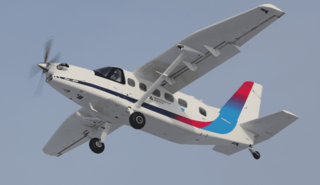
A business jet, private jet, or bizjet is a jet aircraft designed for transporting small groups of people, typically business executives and high-ranking associates. Business jets are generally designed for faster air travel and more personal comfort than commercial aircraft, and may be adapted for other roles, such as casualty evacuation or express parcel deliveries, and some are used by public bodies, government officials, VIPs, or even the armed forces.

A regional airliner or a feederliner is a small airliner that is designed to fly up to 100 passengers on short-haul flights, usually feeding larger carriers' airline hubs from small markets. This class of airliners is typically flown by the regional airlines that are either contracted by or subsidiaries of the larger airlines. Regional airliners are used for short trips between smaller towns or from a larger city to a smaller city. Feederliner, commuter, and local service are all alternative terms for the same class of flight operations.

An electric aircraft is an aircraft powered by electricity. Electric aircraft are seen as a way to reduce the environmental effects of aviation, providing zero emissions and quieter flights. Electricity may be supplied by a variety of methods, the most common being batteries. Most have electric motors driving propellers or turbines.

A hydrogen-powered aircraft is an aeroplane that uses hydrogen fuel as a power source. Hydrogen can either be burned in a jet engine or another kind of internal combustion engine, or can be used to power a fuel cell to generate electricity to power an electric propulsor. It cannot be stored in a traditional wet wing, and hydrogen tanks have to be housed in the fuselage or be supported by the wing.

The PC-Aero Elektra One is a single seat, electric powered composite aircraft.

The Bye Aerospace eFlyer 2 is a light electric aircraft designed and under development by Bye Aerospace of Denver, Colorado.

The NASA X-57 Maxwell was an experimental aircraft being developed by NASA, intended to demonstrate technology to reduce fuel use, emissions, and noise. The first flight of the X-57 was scheduled to take place in 2023, but the program was cancelled due to problems with the propulsion system.

The Lilium Jet is a prototype German electric vertical take-off and landing (eVTOL) electrically powered airplane designed by Lilium GmbH. A seven-seat production version is planned.

Zunum Aero was an aircraft manufacturer startup based in Kirkland, Washington. Backed by Boeing HorizonX and JetBlue Technology Ventures, the company worked from 2013 to 2018 on a proposed family of hybrid electric regional aircraft of up to 50 seats.

The Eviation Alice is an electric aircraft designed to accommodate nine passengers and two crew members. First developed in Israel, its construction incorporates 95% composite material, is powered by two electric motors, and has a T-tail. The prototype first flew on 27 September 2022.

Wright Electric is an American startup company developing an electric airliner.
The Bye Aerospace Sun Flyer is an electric aircraft that was developed from the PC-Aero Elektra One by Bye Aerospace's Aero Electric Aircraft Corporation division of Denver, Colorado, United States, introduced in 2015. The company had a license agreement and engineering contract for the design with Calin Gologan, the Elektra One's designer.
Bye Aerospace is an American aircraft manufacturer based in unincorporated Arapahoe County, Colorado. The company specializes in the design and manufacture of electric aircraft, including unmanned aircraft for geospatial role and light aircraft for the flight training role. The company was founded by George E. Bye, who remains the CEO.
magniX is an electric motor manufacturer for electric aircraft, wholly owned by Singapore investor Clermont Group. The company is headquartered in Everett, Washington, United States.

The VoltAero Cassio is a family of hybrid electric aircraft being developed by startup company VoltAero. The company plans to produce three configurations of the Cassio aircraft: the four-place Cassio 330, the six-place Cassio 480, and the ten-place Cassio 600.
A hybrid electric aircraft is an aircraft with a hybrid electric powertrain. As the energy density of lithium-ion batteries is much lower than aviation fuel, a hybrid electric powertrain may effectively increase flight range compared to pure electric aircraft. By May 2018, there were over 30 hybrid electric aircraft projects, and short-haul hybrid-electric airliners were envisioned from 2032.
The Ampaire Electric EEL is a hybrid electric aircraft developed by U.S. startup Ampaire, established in Hawthorne, California. The forward piston engine of a Cessna 337 Skymaster is replaced by an electric motor powered by a battery, in a parallel hybrid configuration. The demonstrator first flew on 6 June 2019.

Project Fresson is the development by Cranfield Aerospace of an electric propulsion system for the over 700 BN-2 Islanders currently operated, supported by Britten-Norman.

ZeroAvia is a British/American hydrogen-electric aircraft developer. The company was founded in 2017 by Valery Miftakhov, who currently serves as the company CEO. ZeroAvia is developing hydrogen-fueled powertrain technology aiming to compete with conventional engines in propeller aircraft, with an aim of zero-emission and lower noise. ZeroAvia expects to sell products by 2023 and demonstrate flights up to 500 miles (800 km) in aircraft of up to 20 seats. According to the company, by 2026, ZeroAvia intends to fly an aircraft over 500 miles range in aircraft with up to 80 seats.

The UZGA LMS-901 Baikal is a utility aircraft produced by UZGA . The Russian Ministry of Industry and Trade selected UZGA in October 2019 to develop a replacement for the widespread Antonov An-2. The prototype made its maiden flight on 30 January 2022. The aluminum, single-turboprop airplane is powered by a GE H80 or a Klimov VK-800. It is planned to carry a 2 t (4,400 lb) payload or 9–12 passengers over 1,500 km (810 nmi) at 300 km/h (160 kn) from short unpaved airstrips.















